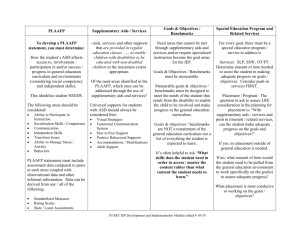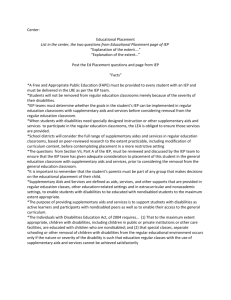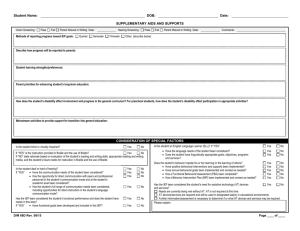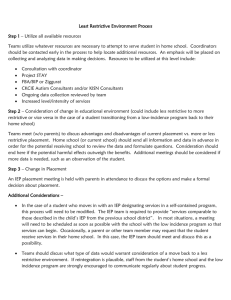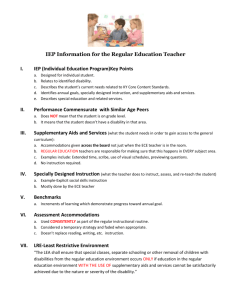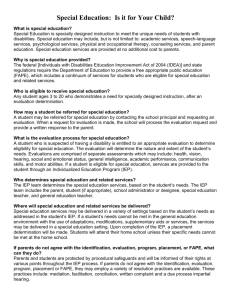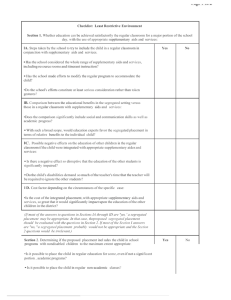special education rights and responsibilities
advertisement
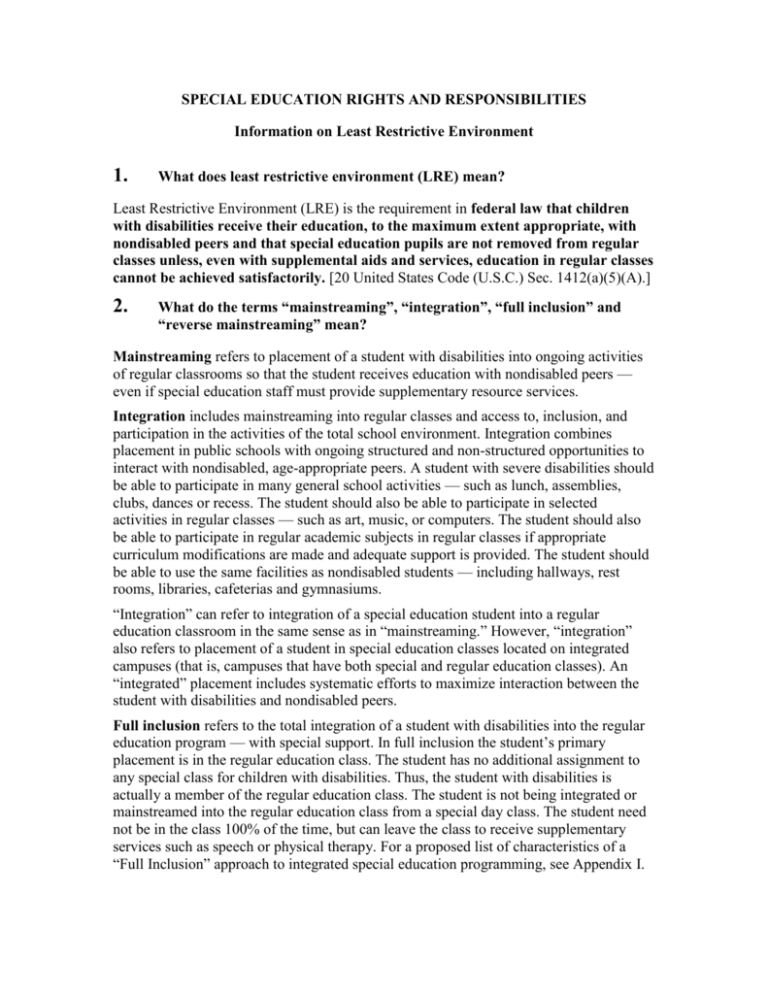
SPECIAL EDUCATION RIGHTS AND RESPONSIBILITIES Information on Least Restrictive Environment 1. What does least restrictive environment (LRE) mean? Least Restrictive Environment (LRE) is the requirement in federal law that children with disabilities receive their education, to the maximum extent appropriate, with nondisabled peers and that special education pupils are not removed from regular classes unless, even with supplemental aids and services, education in regular classes cannot be achieved satisfactorily. [20 United States Code (U.S.C.) Sec. 1412(a)(5)(A).] 2. What do the terms “mainstreaming”, “integration”, “full inclusion” and “reverse mainstreaming” mean? Mainstreaming refers to placement of a student with disabilities into ongoing activities of regular classrooms so that the student receives education with nondisabled peers — even if special education staff must provide supplementary resource services. Integration includes mainstreaming into regular classes and access to, inclusion, and participation in the activities of the total school environment. Integration combines placement in public schools with ongoing structured and non-structured opportunities to interact with nondisabled, age-appropriate peers. A student with severe disabilities should be able to participate in many general school activities — such as lunch, assemblies, clubs, dances or recess. The student should also be able to participate in selected activities in regular classes — such as art, music, or computers. The student should also be able to participate in regular academic subjects in regular classes if appropriate curriculum modifications are made and adequate support is provided. The student should be able to use the same facilities as nondisabled students — including hallways, rest rooms, libraries, cafeterias and gymnasiums. “Integration” can refer to integration of a special education student into a regular education classroom in the same sense as in “mainstreaming.” However, “integration” also refers to placement of a student in special education classes located on integrated campuses (that is, campuses that have both special and regular education classes). An “integrated” placement includes systematic efforts to maximize interaction between the student with disabilities and nondisabled peers. Full inclusion refers to the total integration of a student with disabilities into the regular education program — with special support. In full inclusion the student’s primary placement is in the regular education class. The student has no additional assignment to any special class for children with disabilities. Thus, the student with disabilities is actually a member of the regular education class. The student is not being integrated or mainstreamed into the regular education class from a special day class. The student need not be in the class 100% of the time, but can leave the class to receive supplementary services such as speech or physical therapy. For a proposed list of characteristics of a “Full Inclusion” approach to integrated special education programming, see Appendix I. Reverse mainstreaming refers to the practice of giving a student who is placed at a segregated school site, in a segregated classroom, or who resides in and attends school at a state hospital opportunities to interact with nondisabled children. It brings nondisabled children to a segregated site or to state hospital classrooms for periods of time to work with or tutor children with disabilities. School districts should not attempt to fulfill the LRE mandate by using reverse mainstreaming exclusively. They should make systematic efforts to get special education students out of special classrooms and into the school’s integrated environments. Reverse mainstreaming alone is an artificial means of integration. The IEP team should consider placements that encourage more natural interaction with nondisabled peers. Special and regular educators must make innovative and systematic efforts to promote positive interactions between students with disabilities (both severely disabled and learning disabled) and their nondisabled peers. 3. What are the major legislative and judicial provisions of law underlying the least restrictive environment requirement? Federal law provides that each local education agency must ensure that: ...to the maximum extent appropriate, children with disabilities, including children in public or private institutions or other care facilities, are educated with children who are not disabled, and special classes, separate schooling or other removal of children with disabilities from the regular educational environment occurs only when the nature or severity of the disability of a child is such that education in regular classes with the use of supplementary aids and services cannot be achieved satisfactorily. [34 Code of Federal Regulations (C.F.R.) Sec. 300.550(b)(1) and (2); 20 U.S.C. Sec. 1412(a)(5)(A); California Education Code (Cal. Ed. Code) Sec. 56364.] In addition to the requirement quoted above, Congress has recognized that a state’s method of funding special education services can sometimes encourage school districts to place children in specialized settings because of the potential to receive more money. Because of this danger, Congress now requires states to develop policies and procedures to assure that their funding systems, if based on type of setting, do not violate the requirements of education in the least restrictive environment. [20 U.S.C. Sec. 1412(a)(5)(B).] In its 1997 amendments to the federal special education laws, Congress has specifically recognized the importance and benefits of education of special education students in regular classes and environments. See 20 U.S.C. Sec. 1400(c)(5)(A) and (D). Beginning in July 1998, Congress required that IEPs include a statement describing how the child’s disability affects his involvement and progress in the general curriculum and a statement of annual goals, including benchmarks or short-term objectives that are related to enabling the child to be involved and progress in the general curriculum. [20 U.S.C. Sec. 1414(d)(1)(A)(i) and (ii); 34 C.F.R. Sec. 300.347(a)(2).] The statement of services in the IEP must also include statements of: (1) The supplemental aids and services to be provided for the child; and (2) The program modifications and supports for school personnel to be provided for him to be involved, progress in the general curriculum, and participate in extracurricular and nonacademic activities. [20 U.S.C. Sec. 1414(d)(1)(A)(iii); 34 C.F.R. Sec. 300.347(a)(3).] The U.S. Department of Education (USDOE) issued new regulations in March 1999 that further clarify the responsibility of schools to educate children with disabilities in the least restrictive environment. The USDOE also published its discussion and rationale for making certain changes to regulations governing the least restrictive environment, among other topics. For example, the USDOE stated: Placement in the LRE requires an individual decision, based on each child’s IEP, and based on the strong presumption of the IDEA that children with disabilities be educated in regular classes with appropriate aids and supports…The regulations have always required that placement decisions be based on the individual needs of each child with a disability and prohibited categorical decision-making. [64 Fed. Reg. 12637 (3/12/99) (emphasis added).] While the Act and regulations recognize that IEP teams must make individualized decisions about the special education and related services, and supplementary aids and services, provided to each child with a disability, they are driven by IDEA’s strong preference that, to the maximum extent appropriate, children with disabilities be educated in regular classes with their nondisabled peers with appropriate supplementary aids and services. [34 C.F.R. Part 300, Appendix A. I; 64 Fed. Reg. 12470 (3/12/99) (emphasis added).] Even though IDEA does not mandate regular class placement for every disabled student, IDEA presumes that the first placement option considered for each disabled student by the student’s placement team, which must include the parent, is the school the child would attend if not disabled, with appropriate aids and services to facilitate such placement. Thus, before a disabled child can be placed outside of the regular educational environment, the full range of supplementary aids and services that if provided would facilitate the student’s placement in the regular classroom setting must be considered. [34 C.F.R. Part 300, Appendix A, Q. 1; 64 Fed. Reg. 12471 (3/12/99) (emphasis added).] State law provides that: Individuals with exceptional needs [shall be] offered special assistance programs that promote maximum interaction with the general school population in a manner which is appropriate to the needs of both. [Cal. Ed. Code Sec. 56001(g).] Special classes that serve pupils with similar and more intensive educational needs shall be available. The special classes may enroll the pupils only when the nature or severity of the disability of the individual with exceptional needs is such that education in the regular classes with the use of supplementary aids and services, including curriculum modification and behavioral support, cannot be achieved satisfactorily. These requirements also apply to separate schooling, or other removal of individuals with exceptional needs from the regular education environment. In providing or arranging for the provision of activities, each public agency shall ensure that each individual with exceptional needs participates in those activities with nondisabled pupils to the maximum extent appropriate to the needs of the individual with exceptional needs, including nonacademic and extracurricular services and activities… [Cal. Ed. Code. Sec. 56364(a)(b).] For students not yet receiving special education, but for whom special education eligibility is being considered, state law provides that: A pupil shall be referred for special educational instruction and services only after the resources of the regular education program have been considered and, where appropriate, utilized. [Cal. Ed. Code Sec. 56303.] The LRE regulations of federal law, Title 34, Code of Federal Regulations, Section 300.552(c) and (d) provide: Unless the IEP [individualized education program] of a child with a disability requires some other arrangement, the child is educated in the school that he or she would attend if non disabled; [and] [i]n selecting the least restrictive environment, consideration is given to any potential harmful effect on the child or on the quality of services that he or she needs. Numerous federal courts have issued decisions on the issue of special education in the least restrictive environment. For the most part, these courts have encouraged integrated education and have established a solid trend in this direction. There is “a presumption that, among the alternative programs of education and training required by statute to be available, placement in a regular public school class is preferable to placement in a special public school class.” [P.A.R.C. v. Pennsylvania.] The court adopted “a presumption that among the alternative programs of education, placement in a regular public school class with appropriate ancillary services is preferable to placement in a special school class.” [Mills v. Board of Education.] The U.S. Supreme Court has stated: “The Act requires participating states to educate handicapped children with nonhandicapped children whenever possible.” [Board of Education v. Rowley.] In California, the federal appeals court has stated that the: “Congressional preference for educating handicapped children in classrooms with their peers is made unmistakably clear.” [Dept. of Educ., State of Hawaii v. Katherine D.] Denying access to a regular public school classroom without a compelling education justification constitutes discrimination. [Tokarcik v. Forest Hills School District.] Federal special education law “requires school systems to supplement and realign their resources to move beyond those systems, structures and practices which tend to result in unnecessary segregation of children with disabilities.” [Oberti v. Board of Education.] The courts, including the federal courts in California, have established that the burden is on the school district to prove that a student cannot be educated successfully in the regular classroom. “[T]he District has not justified, to the satisfaction of this reviewing court, its decision to exclude [the student] from a regular classroom.” [Mavis v. Sobol.] “[T]he Act’s strong presumption in favor of mainstreaming...would be turned on its head if parents had to prove that their child was worthy of being included, rather than the school district having to justify a decision to exclude the child from the regular classroom. [Oberti v. Board of Education.] “The statutory presumption in favor of mainstreaming has been construed as imposing a burden on the school district to prove that a child cannot be mainstreamed. [Sacramento City Unified School District v. Holland.] 4. What factors may be important in determining whether my child is being educated to the maximum extent appropriate with her nondisabled peers? In the case of Sacramento City Unified School District v. Holland, the court identified several factors which are critical in analyzing whether a school district is complying with the least restrictive environment mandate. These factors are: (1) Educational benefits available to the student with a disability in a regular classroom, supplemented with appropriate aids and services, as compared with educational benefits of a special education classroom; (2) Nonacademic benefits of interaction with children who are not disabled; (3) Effect on the teacher and the other children in the classroom of the presence of the student with disabilities in terms of disruptive behavior and/or undue consumption of the teacher’s time; (4) Cost of mainstreaming a student with disabilities in a regular education classroom as compared to the cost of placement of the student in a special education classroom. No single factor is determinative. Even if a child might make more progress on academic IEP goals in a special class, the IEP team should still consider the second factor regarding nonacademic benefit before determining placement. As long as the progress made is satisfactory, the educational benefit factor of Holland is met, even if the progress is not the most that the child could make in another setting. However, it is clear from court decisions subsequent to Holland that if a child would not benefit from placement in a regular class or environment, that is, the child would not progress toward meeting her IEP goals, placement in a regular classroom or environment is unlikely. [Hartmann by Hartmann v. Loudoun County Bd. Of Educ. (4th Cir. 1997); Poolaw v. Bishop (9th Cir. 199th); County of San Diego v. California Special Education Hearing Office (9th Cir. 1996).] Some educational benefit must occur. However, in California, the benefit that must occur in order for an IEP and placement to be appropriate is not substantial. The Court in Holland stated: “The [IDEA’s] presumption in favor of mainstreaming requires that a handicapped child be educated in a regular classroom if the child can receive a satisfactory education there, even if it is not the best academic setting for the child.” Moreover, the determination of whether a child will make progress toward IEP goals must be made in the context of whether the child will make progress if supplementary aids and services are offered to support the child in the regular environment. [20 U.S.C. Sec. 1415(a)(5)(A); 34 C.F.R. Sec. 300.550.] 5. Does the district have to provide aids and services to assist my child’s integration? What if the district says that providing those aids and services is too expensive? The district must provide supplementary aids and services to accommodate the special educational needs of students with disabilities in integrated environments. The court in Oberti v. Bd. Of Educ. stated that a district must take meaningful steps to include children with disabilities in regular classrooms with supplementary aids and services. In another appellate court opinion, Daniel R. v. El Paso Independent School District, the court said: The [law] does not permit states to make mere token gestures to accommodate handicapped students; its requirement for modifying and supplementing regular education is broad. Another federal appellate court opinion, Roncker v. Walter, contained the following statements on the LRE issue: In a case where [a] segregated facility is considered [academically] superior, the court should determine whether the services which make the placement superior could be feasibly provided in a non-segregated setting. If they can, the placement in the segregated school would be inappropriate under the [law]. The Roncker court also noted that: Cost is a proper factor to consider since excessive spending on one handicapped child deprives other handicapped children. Cost is no defense, however, if the school district has failed to use its funds to provide a proper continuum of alternative placements for handicapped children. The provision of such alternative placements benefits all handicapped children. While the court in Holland decided that cost was a consideration in determining the appropriate placement for a child, it found that providing a part-time instructional aide and making academic curriculum modifications would not cost more than a special education placement. Even though a school district may say it does not have the money to pay for supplementary aids and services in regular environments, what may actually be happening is that the district does not have a convenient method under the special education funding system to pay for the supplementary aids and services. In any case, insufficient funds to pay for a needed service is not a legally sufficient justification for refusing to provide them, except, perhaps, when the costs would significantly impact the education of other children in the district. 6. The district told me that my child may not be integrated because he cannot benefit academically from regular class instruction. Is this true? No. The court in Holland noted that mainstreaming requires educating a student with disabilities in a regular classroom if the child can receive a satisfactory education there, even if it is not the best academic setting for the child. The court looked at whether the student’s IEP goals and objectives could be met in the classroom with some curriculum modification, or by providing supplementary aids and services. The school district in Holland contended that a child should be found inappropriate for regular class placement if such placement would require significant modification of the regular curriculum for the child. The Court rejected this contention and found that special education pupils may require and be entitled to substantial curriculum modifications in order to facilitate their benefit from regular class placement. The Court stated that “modification of the curriculum for a handicapped child, even dramatic modification, has no significance in and of itself. The IDEA, in its provision for the IEP process, contemplates that the academic curriculum may be modified to accommodate the individual needs of handicapped children.” Another federal appellate court opinion, Oberti v. Board of Education of the Borough of Clementon School District, contained the following comments on academic benefit: [IDEA] does not require states to offer the same educational experience to a child with disabilities as is generally provided for nondisabled children... To the contrary, states must address the unique needs of a disabled child, recognizing that child may benefit differently from education in the regular classroom than other students... In short, the fact that a child with disabilities will learn differently from his or her education within a regular classroom does not justify exclusion from that environment. The USDOE has also clarified this point in its 1999 special education regulations. Because, as commentators noted, one consequence of heightened accountability expectations may be unwarranted decisions to remove children with disabilities from regular classrooms so as to avoid accountability for their education performance, the regulation should make clear that the type or extent of the modifications that the child needs to the general curriculum not be used to inappropriately justify the child’s removal from education in regular, ageappropriate classrooms. Therefore, a provision [is] added to Sec. 300.552 to provide that a child not be denied education in ageappropriate regular classrooms solely because the child’s education required modification to the general curriculum. Under this provision, for example, a child with significant cognitive disabilities could not be removed from education in age-appropriate regular classrooms merely, because of the modifications he or she needs to the general curriculum.[64 Fed. Reg. 12637 (3/12/99); see also 34 C.F.R. Sec. 300.552(e).] Negotiating goals that are related to the general education curriculum is no longer difficult because, as of 1997, federal law requires that special education pupils have access to and benefit from the general education curriculum. Special education pupils are now entitled to these kinds of goals. The statement of a child’s present levels of educational performance in the IEP must contain a statement of how the child’s disability affects his involvement and progress in the general curriculum (i.e., the same curriculum as for nondisabled children). [34 C.F.R. Sec. 300.347(a)(2).] The statement of goals and benchmarks/objectives in the IEP must relate to meeting the child’s needs that result from the child’s disability to enable the child to be involved and progress in the general curriculum. [34 C.F.R. Sec. 300.347(a)(2).] The special education and related services and supplementary aids and services listed in the IEP must be provided to enable the child to be involved and progress in the general curriculum and to participate in extracurricular and other nonacademic activities. [34 C.F.R. Sec. 300.347(a)(3).] The IEP must also contain a statement of any individual modifications in the administration of state or district-wide assessments of student achievement that are needed in order for the child to participate in the assessments. [34 C.F.R. Sec. 300.347(a)(5).] In other words, all the major components of the IEP are directed at including special education students in the general curriculum, activities, and achievement testing of the school. Therefore, goals and objectives must be written which are based on this curriculum and those activities. Goals and benchmarks/objectives of this type will most often necessitate placement in a general education environment. Goals and benchmarks/objectives that are based on the general curriculum need not call for mastery of the subject matter or even for completion of every task or activity. An appropriately accommodating goal and benchmark/objective for a student with disabilities might call for learning only a portion or the first few steps of a skill that nondisabled students might go on to complete. The important factor in analyzing the appropriateness of that placement for the student with disabilities may be the fact that she is participating to some degree in the activities of the surrounding classroom. Benchmarks/objectives that require integrated activities are another means of ensuring integration. Such a goal might read: “Sandra will participate in a team sport with nondisabled peers three times per week for 45 minutes per activity.” Including such goals assures your child of regular contact with nondisabled children. Holland also stressed the importance of nonacademic benefits derived from a regular education classroom placement for students with disabilities. Because of the importance the court in Holland gave to nonacademic benefits, the IEP should also include information and goals and benchmarks/objectives related to the nonacademic benefits of an integrated placement. Such benefits for a student with a disability may include language and behavioral models; improved self-esteem and increased motivation for learning; or improved social skills. 7. Must the determination of whether my child would be too disruptive in the classroom be made in light of the possibility of supplementary aids and services to address my child’s behavior? Yes. Before making the determination that a special education student would be so disruptive as to significantly impair the education of the other students, the district must ensure that consideration has been given to the full range of supplementary aids and services that could be provided to the student in the regular education environment to accommodate the unique needs of the special education student. [Questions and Answers on the Least Restrictive Environment Requirements of the IDEA, U.S. Department of Education, Office Of Special Education and Rehabilitative Services, OSEP-95-9, 11/23/94, Q and A 9.] The Court in Sacramento City Unified School District v. Holland stated that “when evaluating the burden that would be created by placing a handicapped child in a regular education class, the school district must consider all reasonable means to minimize the demands on the teacher: A handicapped child who merely requires more teacher attention than most other children is not likely to be so disruptive as to significantly impair the education of other children. In weighing this factor, the school district must keep in mind its obligation to consider supplemental aids and services that could accommodate a handicapped child’s need for additional attention...This factor weighs against placing a handicapped child in regular education only if, after taking all reasonable steps to reduce the burden to the teacher, the other children in the class will still be deprived of their share of the teacher’s attention.” [Sacramento City Unified School District v. Holland.] Federal law now requires that an IEP team consider behavior intervention strategies for any child with a disability whose behavior impedes his or her learning or that of others. [20 U.S.C. Sec. 1414(3)(3)(B)(i); 34 C.F.R. Sec. 300.346(a)(2)(i).] The determination of appropriate placement for a child whose behavior is interfering with the education of others requires careful consideration of whether the child can appropriately function in the regular classroom if provided appropriate behavioral supports, strategies and interventions. If the child can appropriately function in the regular classroom with appropriate behavioral supports, strategies or interventions, placement in a more restrictive environment would be inconsistent with the least restrictive environment provisions of the IDEA. [64 Fed. Reg. 12637 (3/12/99) (emphasis added).] In response to contentions about negative effects of special education students on regular education students in regular classes, it should be noted that federally funded research projects indicate that: (1) Achievement test performance among students who were classmates of students with significant disabilities were equivalent or better than a comparison group (Salisbury, 1993); (2) Students developed more positive attitudes toward peers with disabilities (Cal. Research Institute, 1992); and (3) Self-concept, social skills, and problem solving skills improved for all students in inclusive settings (Peck, Donaldson, & Pezzoli, 1990; Salisbury & Palombaro, 1993.). [Idem] 8. What sorts of things may I ask for in the way of supplementary aids and services to assist my child in the regular classroom? The federal law defines supplementary aids and services very broadly as: “aids, services, and other supports that are provided in regular education classes or other educationrelated settings to enable children with disabilities to be educated with nondisabled children to the maximum extent appropriate...” [20 U.S.C. Sec. 1401(29); 34 C.F.R. Sec. 300.28.] There is no all-inclusive list of the supplemental aids and services that might be used to assist special education students in regular classes. However, USDOE in a recent advisory on LRE issues has stated that the IEP team should consider a range of supplementary aids and services in light of the student’s abilities and needs. The determination of what supplementary aids and services are needs must be made on an individual basis. Some aids and services which have been successfully used include, but are not limited to, modifications to the regular class curriculum, assistance of an itinerant special education teacher, special education training for the regular teacher, use of computer-assisted devices, provision of note takers, and the use of a resource room. Any supplemental aids and services used must be described in the student’s IEP. [Questions and Answers on the Least Restrictive Environment Requirements of the IDEA, U.S. Department of Education, Office Of Special Education and Rehabilitative Services, OSEP-95-9, 11/23/94, Questions 3 and 4.] One federal appellate court described the provision regarding supplemental aids and services as follows: “[The federal special education] Act does not permit states to make mere token gestures to accommodate handicapped students; its requirement for modifying and supplementing regular education is broad.” [Daniel R. v. El Paso Independent School District.] 9. Does regular education staff have to cooperate in providing my child with integration, full inclusion and mainstreaming opportunities? Special education law requires that the IEP document specify the supplementary aids and services necessary to ensure a student’s participation in the regular education program. [20 U.S.C. Sec. 1414(d)(1)(A)(iii).] These supplementary aids and services might include, for example: (4) Special seating arrangements; (5) Modification of tests to accommodate the student’s disability; (6) Curriculum modifications; (7) Instructional, behavioral, or health aides to accompany the student; and (8) Adaptive equipment. Such arrangements apply to any class in which the student might participate — including physical education, art, music and vocational education. [34 C.F.R. Sec. 300.342 and 300.347.] The IEP document is binding on the school district. Therefore, both special and regular education personnel must follow its provisions. The IEP team must include at least one regular education teacher of the child, if the child is or may be participating in regular education. [20 U.S.C. Sec. 1414(d)(1)(B)(ii); 34 C.F.R. Sec. 300.344(a)(2).] The regular education teacher must, to the extent appropriate, participate in the development of the IEP. This includes the determination of appropriate positive behavior interventions and strategies, the determination of supplementary aids and services, program modifications, and support for school personnel in providing the supplementary aids and services and program modifications. [20 U.S.C. Sec. 1414(d)(3)(C); 34 C.F.R. Sec. 300.346(d).] The regular education teacher must also participate in the review and any revision of the IEP of the student. [20 U.S.C. Sec. 1414(d)(4)(B).] Also, the school district must be represented at every IEP meeting by a school official who is knowledgeable about the general curriculum and about the availability of resources of the local educational agency. [20 U.S.C. Sec. 1414(d)(1)(B)(iv); 34 C.F.R. Sec. 300.344(a)(4).] The best way to ensure cooperation between the regular and special education programs is to make sure that adequate training and support are available to the regular education staff regarding the needs of your child. You can accomplish part of this through the IEP planning process by urging your child’s regular education teacher to help draft the IEP by voicing his needs for modifications and support services. See Question 17 above. In addition, technical assistance and training in implementation of the Least Restrictive Environment requirement, as well as ongoing monitoring of local districts for compliance with this requirement, must be available from the State Department of Education to your local school district. [34 C.F.R. Sec. 300.555 and 300.556.] Lastly, each child’s IEP must be made available to each of his teachers and any other staff who will be responsible for its implementation. Further, each teacher and other such person must be informed of his specific responsibilities related to implementing the IEP and the specific accommodations, modifications, and supports that must be provided for the child. [34 C.F.R. Sec. 300.342(b)(2) and (3).] In addition, ODE and the local school districts have general responsibility to ensure that both regular and special education personnel are adequately prepared to provide instruction to special education students. Specifically, school districts must provide inservice training to regular and special education teachers who serve special education students about those students’ needs. This program should include information on the latest educational practices as well as joint training of school personnel and parents. [34 C.F.R. Secs. 300.380, 300.382; Cal. Ed. Code Secs. 56001(o), 56240-43.] 10. Can the lack of a willing regular education teacher prevent my child from being educated in a regular classroom? No. The lack of adequate personnel or resources does not relieve school districts of their obligation to educate a child in the regular classroom in accordance with his IEP. Placement of a student in a particular regular class based on the competencies of the teacher is permitted. The district has an affirmative responsibility to ensure sufficient numbers of regular education teachers who are qualified, with needed aids and supports, to provide services to students with disabilities in regular educational environments. [Questions and Answers on the Least Restrictive Environment Requirements of the IDEA, U.S. Department of Education, Office of Special Education and Rehabilitative Services, OSEP-95-9, 11/23/94, Question 6.]
